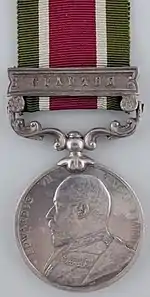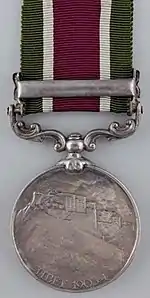| Tibet Medal | |
|---|---|
  Obverse and reverse of the medal, with 'Gyantse' clasp. | |
| Type | Campaign medal |
| Awarded for | Campaign service. |
| Description | Silver or bronze disk 36 mm wide |
| Presented by | United Kingdom of Great Britain and Ireland |
| Eligibility | British Army. |
| Campaign(s) | Tibet 1903–04 |
| Clasps | Gyantse |
| Established | 1 February 1905 |
The Tibet Medal was authorised in February 1905 for all members of the Tibet Mission and accompanying troops who served at or beyond Siliguri from 13 December 1903, to 23 September 1904.[1]
The obverse of the medal, designed by G. W. de Saulles,[2] shows the left-facing bust of Edward VII in Field Marshal's uniform and the legend 'EDWARDVS VII KAISAR-I-HIND'.[1]
The reverse, designed by E. G. Gillick,[2] depicts the Potala (winter palace of the Dalai Lamas) in Lhasa on top of the red hill with the words 'TIBET 1903–04' below.[1]
The suspender is of the swivelling ornate scroll type.[2]
The clasp 'GYANTSE' was given to those present in operations between 3 May and 6 July 1904, in or near Gyantse Fortress.[3]
Both silver and bronze medals were issued named to the recipient on the rim in a cursive script.[2]
The 1.25 inches (32 mm) wide ribbon is maroon, flanked by narrow white, and wider green, stripes.[3]
The medal was awarded in silver to combatant troops and in bronze to camp followers, with both eligible for the 'Gyantse' clasp. Approximately 3,350 silver medals were awarded, including about 600 to the first battalion of the Royal Fusiliers, the only British Army unit present, and about 2,600 to members of the Indian Army, in addition to staff and support personnel.[2] In excess of 2,500 bronze medals were awarded, mainly to those employed in transporting supplies over the difficult terrain, including to the Peshawar Camel Corps[2] and locally-recruited coolies.[4]
See also
References
- 1 2 3 Gould, Robert W. (1982). Campaign Medals of the British Army 1815–1972: An Illustrated Reference Guide for Collectors. Great Britain: Arms and Armour Press. p. 53.
- 1 2 3 4 5 6 Joslin, Litherland and Simpkin. British Battles and Medals. p. 217–8. Published Spink, London. 1988.
- 1 2 John W. Mussell, editor. Medal Yearbook 2015. p. 196. Published Token Publishing Limited, Honiton, Devon. 2015.
{{cite book}}:|author=has generic name (help) - ↑ French, Patrick (1994). Younghusband: The Last Great Imperial Adventurer. Reprint: Flamingo Books, London. ISBN 0-00-637601-0. Pages 235–7 confirm that in May 1904 2,000 coolies with 4,000 yaks and mules were collected in the Chumbi Valley near Sikkim to support the expedition.